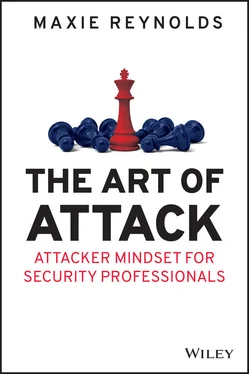At this point, there is less room for flexibility with options and opportunity typically becoming scarcer, too. I like to think of this as a funnel effect; the further you get into an attack and the closer you get to reaching your objective, the fewer options and less freedom you have. There may be only a few moves that would allow you to achieve your desired outcome. Anxiety-inducing stuff.
Here's an example: When approaching a building, you may have the choice of 10 entry and exit points to try. Once inside, you may have three or four routes to the security operations center (SOC), for example. Getting into the SOC may come down to two potential moves: up through the tiled roof and down the other side or through the door should you able to get it open. There's the bonus “option” of randomicity, which may show up as someone walking out of the SOC's security doors, allowing you to walk effortlessly in, but you typically wouldn't count on this. As the funnel effect unfolds, it's easy for anxiety to build.
When the body perceives a stress, it goes into “fight or flight” mode. Our attention gets highly focused and a slew of other bodily changes take place. This innate response is what allows parents to flip cars off their children and injured soldiers to continue fighting. Alas, there is a limit to how beneficial stress is. Too much stress causes performance to suffer. You may also take time to identify the root cause of your nervousness.
Clammy hands. Dry mouth. Shortness of breath. Shaky. Tense body parts. Sound familiar? Nerves. They get too many of us too often. As I've already confessed, I break out in a weird, patchy rash when I am really nervous. The old-age method of picturing your team or target in their underwear is by far the worst idea you'll have on the job, and thankfully you might not need to. Employing your DAMs means you should be able to quash, or at the very least quiet, those nerves before they've taken root. Identifying the root cause of your nerves will help you conceptualize them, which means that you can apply reason to them. This is important for multiple reasons, not the least of which is stamping out that anxiety and enjoying critical thought processes again. The first step is to interrupt that feedback loop.
Anxiety often begins in the amygdalae, which is where your brain processes memory and interprets emotions. It's now understood that you can reduce anxiety signals from your amygdalae if you assign names or labels to the emotions that you're experiencing at the time.
Another effective way to bring back critical thought processes is a breathing technique practiced by the Navy SEALs called tactical breathing . It focuses on slowing your rate of breathing down by pushing the breath through the nostrils, counting to four for each inhale and exhale. This technique might seem simple, but it has a huge impact.
Now, I'd like to note that your DAMs will have to work in concert with your OAMs at many times. For instance, if the root reason for nerves is fear of loss of control, you will have to employ functions from the OAMs “comfort with risk” structure. Sometimes all your DAMs can do is help you identify the origins, which is still a huge help that shouldn't be overlooked. In other cases, DAMs is enough; if the root cause of your nerves is that you feel you don't have enough information, you've underprepared. DAMs will help you ensure this never happens—if you employ it by ensuring you prepare and consider the defenses you will go up against.
Remember, the defensive side of the AMs is what helps a great attacker win consistently and in all conditions. Defensive skills include the capacity to adapt and respond. Through DAMs you know there are many uncontrolled variables, and it's easy to get overwhelmed. Simply knowing this is enough to begin turning the tide. DAMs can give you a high level of understanding and allows you to control anxiety, because defensively you know neither stress nor anxiety will aid your performance and that OAMs has you covered on the opposing side.
Instill in yourself the point of any defensive strategy—to fend off and block what doesn't serve you or that wants to harm you. Prepare and remember your goal, adapt to the situation, and respond with confidence in knowing the attack will never overtake you. You are performing it. DAMs is a regulator; it keeps you calm and allows for a modest amount of caution. Whereby OAMs allows you growth in stressful moments, DAMs regulates the stress you feel so that you actually use it as a driving force, recognizing it as a reason to adapt to, and then apply, your own changes.
Recovery, Distraction, and Maintenance
The skill of quickly recovering from setbacks is a defensive mental skill that pays dividends in lengthy engagements. This, coupled with the ability to focus despite distractions, is a potent combination completely in your favor as an attacker. This is critical at times where distractions increase in proportion to the size and importance of the job. It also helps prevent false positive opportunity identification. Not every incident or event is an opportunity for you as an attacker—sometimes it's just good enough to be able to observe them, with no need to act.
Finally, mental maintenance skills, or the ability to maintain simple, effective thoughts under pressure, is often the difference between having a great plan and executing a great plan. DAMs should amount to consistent performance and continued success on jobs.
OAMs and DAMs Come Together
There is overlap between the two sides no matter how you slice it. Having them categorized within our minds isn't important. Looking at the skills and building them up together is the real goal.
Offensive mental skills allow attackers to achieve what most ordinary people would find hard to believe, never mind actually perform. Defensive mental skills give attackers consistency and resiliency. The combination of both will result in a powerful attacker, able to test the most hardened of defenses and also able to provide solution-based feedback for clients left feeling shattered, most often because they could not have conceived of such an attack mere hours before it was performed. The performance of an attacker missing either of these skills will be diminished.
OAMs: offensive attacker mindset
DAMs: defensive attacker mindset
The offensive attacker mindset allows you to direct an event in the direction of the objective and be comfortable with the risk of doing so.
A defensive attacker mindset will help an attacker win consistently and in all conditions.
DAMs also teaches you that getting to the root cause of an anxious feeling will help take it from a feeling to a thought that can be broken down and dealt with and, hopefully, eradicated.
Whereas your OAMs wants you to pivot at every possible opportunity that presents itself, your DAMs holds you back when necessary, knowing that not every incident or event is an opportunity and that observation without action can be just as powerful.
Whenever the two are in conflict, OAMs will push you to do what it takes to win; DAMs will pull you to use caution, urging you to not take big risks.
If there's no life-threatening danger, and you are closing in on the end of an attack, you should go for the win. If the risk you need to take in that moment threatens the rest of the engagement, fall back and reassess.
Being able to think straight and maintain effective thoughts under pressure is key when working in a hectic or fluid situation. Preparation and staying aligned with your goal and adapting to the situation are critical. Your mental agility is a great asset, as is believing the attack will never overtake you. You are performing it. You have as much control as you will ever have. The rest is chance. Find comfort in that.
Читать дальше












